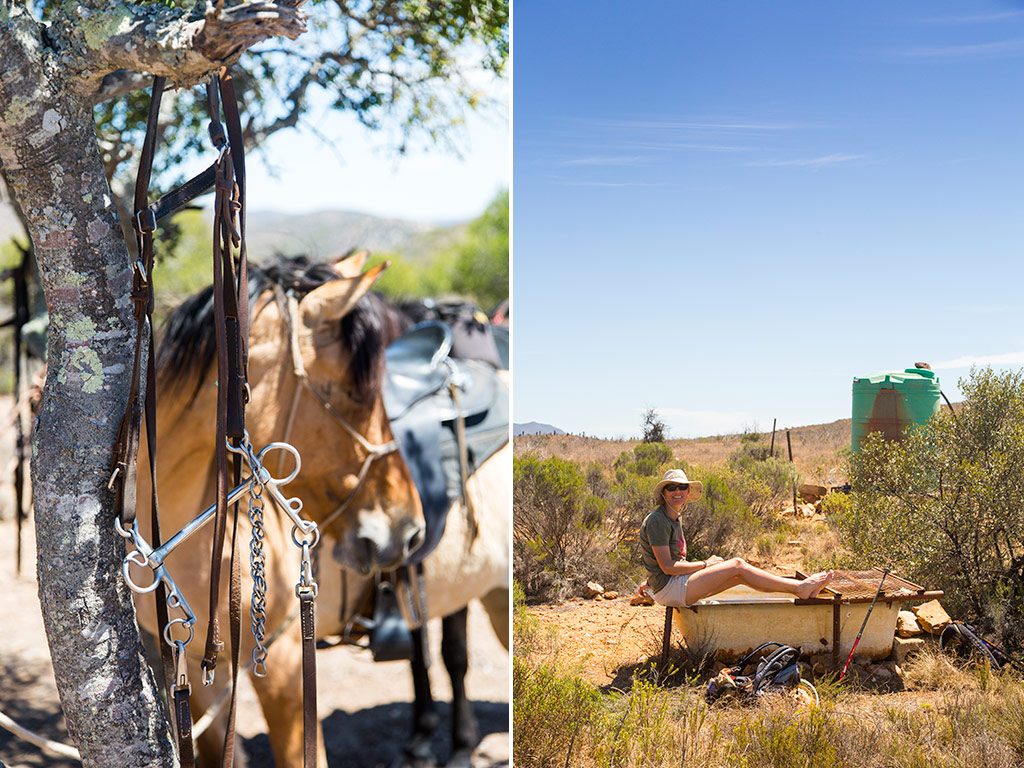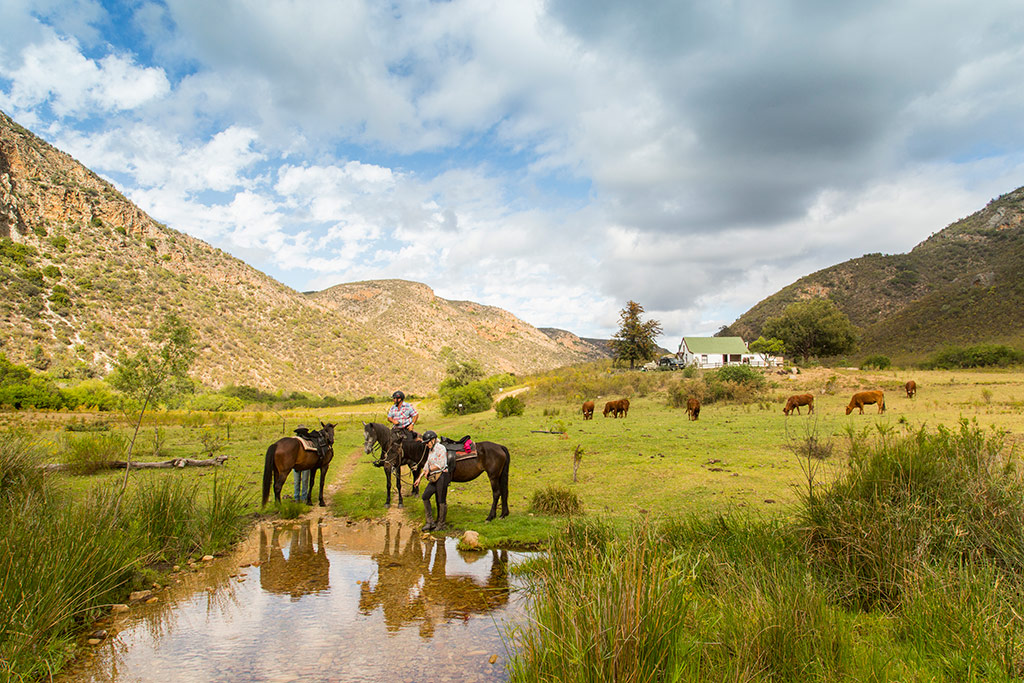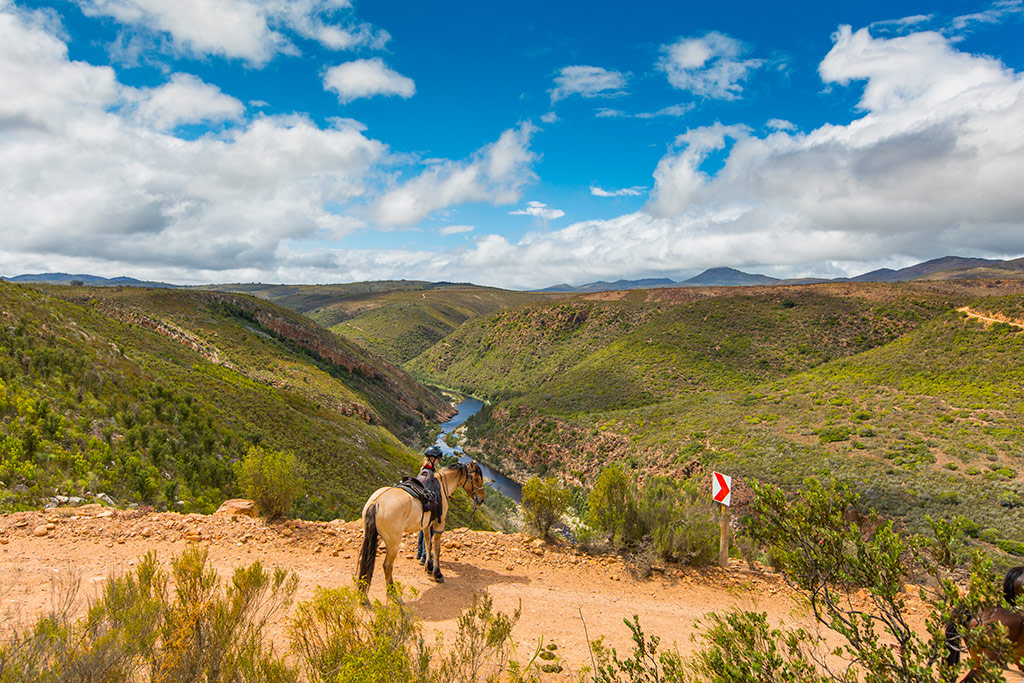
A new hike allows the not-so-fit to ride alongside those on foot into the depths of the Baviaanskloof. We were the first to test it out, and found that there’s a magic that happens when you explore this wilderness from a saddle. Photos by Teagan Cunniffe.
For more behind the scenes photos: Scenes from the Baviaans Camino
It is a rude awakening, on the first day of the Baviaans Camino, to realise that I’ve been very wrong for a long time.
A sweet breeze is singing in the fynbos as I fumble for a naartjie in my saddlebag, still cool from the morning. Wieda, the beautiful strawberry roan I was introduced to a few hours ago, is crunching up a hill like she was born to do it. We’ve already climbed over a thousand metres in elevation this morning, and have many kilometres of mountain pass ahead of us, but Wieda doesn’t seem concerned, so neither am I. I start peeling my naartjie.
Part of the joy of hiking is triumph over adversity. It’s hard sometimes, and necessarily so; when your knees are wobbling, and your lungs are imploding, and you’re too focused on putting one foot in front of the other to worry about that metallic taste in your mouth. You somehow manage to keep going, and you finally reach that ridge, or peak, or waterfall, and suddenly … bliss. Your struggle meant something, in a very literal sense; it was your pain that brought you here. For a person who loves hiking but is perennially unfit, the epiphany of conquering your own body is one of the most addictive things about hiking – and it makes the beer afterwards taste that much sweeter.
But, nibbling a naartjie on horseback, I have to admit that there might be other ways of doing things.
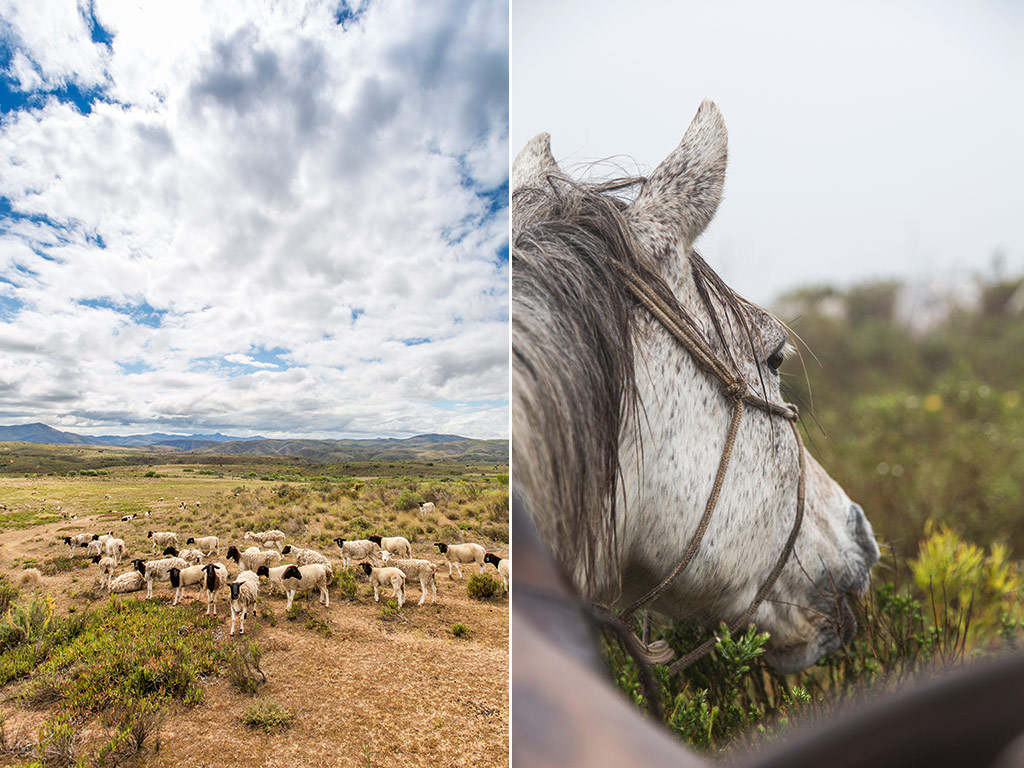
LEFT: Other creatures are scarce in these mountains, but you’ll see sheep from time to time. RIGHT: this lovely horse was named Noodle.
The Baviaans Camino is a new five-day trail in which both horse riders and hikers take on some of the most inhospitable terrain in South Africa. There are 12 of us on this, the inaugural journey; five on horses, seven on foot. Most people fall silent at the mention of the Baviaanskloof. It seems to have a similar mythology to the open spaces of Namibia, where people, after struggling for words, fall back on ‘It’s very … big.’ This eloquent description tends to be based on the R332, a winding dirt road that runs from Willowmore to Patensie. But if you’re not restricted by four wheels, you can take a route that runs perpendicular to that, taking you directly over the spine of the Baviaanskloof into much wilder territory.
Also see: photos from the Leopard Trail, in the Baviaanskloof
‘Wilted’ is perhaps the kindest adjective for how the hikers are doing today; after all, they’ve climbed the equivalent of Table Mountain and still have another 11 kilometres to go. It’s the steepest climb of the trip – the steepest of most trips, I think – and they’re needing to dig deep.
We finally crest over the clenched fist of the Baviaanskloof, and on the other side is a steeper challenge: loose scree, tumbling impossibly downwards like a paused avalanche. The horses seem to be shod with rubber, and they pick their way through the shifting path with deliberation and confidence. It seems impossible. But these horses are extraordinary.
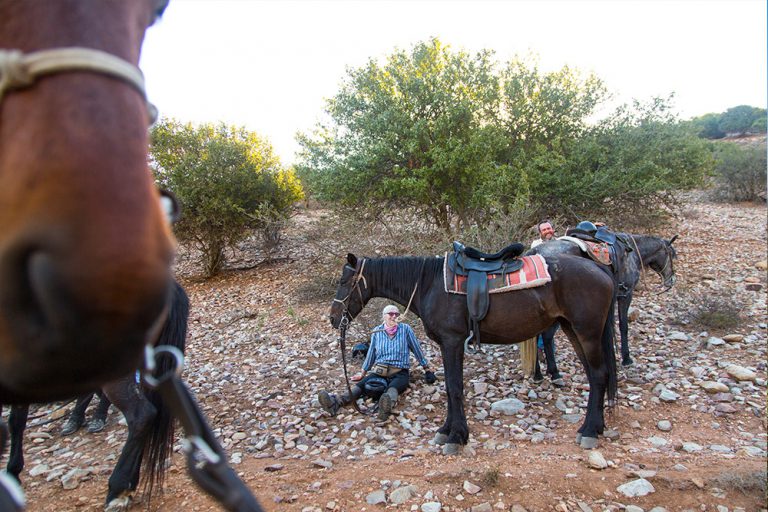
Knackered! And that’s the riders and horses – the hikers proved their mettle by pushing on past us at our pitstop.
That’s not according to me, by the way. That’s according to Lynda, an avid horsewoman who spent a month riding a thousand kilometres across Namibia. (She is the sort of rider who brought her own saddle on this trip.)
The thing about this kind of terrain, especially when you’re working with novices, is that you need horses who know what they’re doing. Wieda is a Boerperd with the face of an angel and the heart of a saint, and at this point I am really just trusting her judgement rather than trying to ride. She’s taking this as a suggestion to snack whenever possible, so I figure we’re already two peas in a pod.
We see no shade until we reach the Doringkloof valley and thorn trees close up above us. Everything is silent except for the horses’ hooves crunching over the bright white pebbles of a dry riverbed. We’ve been in the saddle for over seven hours. But nobody mentions how their body aches as we watch the dust hanging sublime in the air, brilliant as a sun flare.
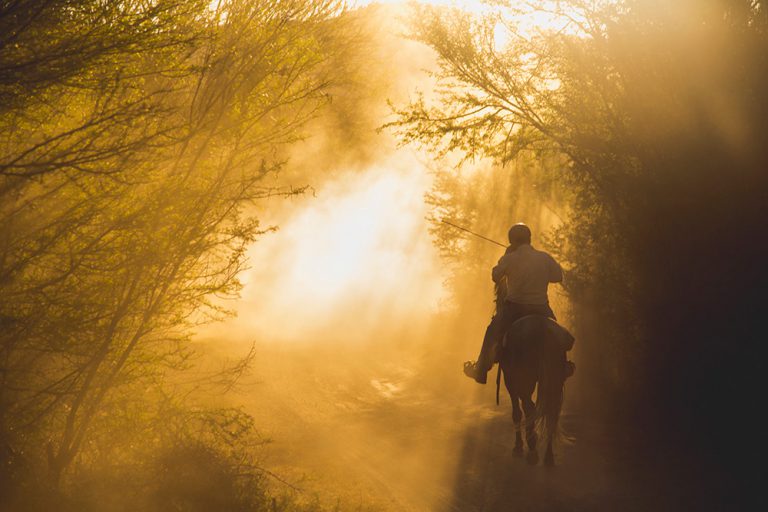
The afternoon sun caught the dust kicked up by the support vehicle, turning it gold as Hercules and Diamant walked through.
The experience might be bliss, but it certainly isn’t luxury. You’re the one untacking your horse, taking it to water, washing it down, feeding it dinner – before you’ve taken off your shoes. If you don’t know your way around a saddle, you’re going to have to learn sharpish. It’s a bit like sailing, with all those fiddly knots; and a bit like motorbikes, but instead of gears and levers there are eternal numbers of straps and buckles.
There is also the ridiculous lexicon, surely some sort of centuries-old practical joke: words like snaffle, pommel, numnah. But the most important thing about mucking around with horses is actually getting to know horses; the simple, old-fashioned process of making friends with another creature. Unlike the dead-eyed drones you’ll find doing the rounds along seasides or at children’s parties, these horses have quirks and personalities. And watching these silly, wise, beautiful animals throw themselves at the sweet grass as if it’s an all-you-can-eat sushi buffet is charming.
The next day we wake to an excessive farm breakfast: mieliepap and oats, bacon and eggs, roosterkoek, mushrooms and baked beans, in vats large enough to drown a donkey. We brush the horses until they glimmer, saddle up and get back on the road. A fire swept through this area about a month ago, so the mountains stretching ahead of us are hard and blackened, like a burnt crème brûlée.
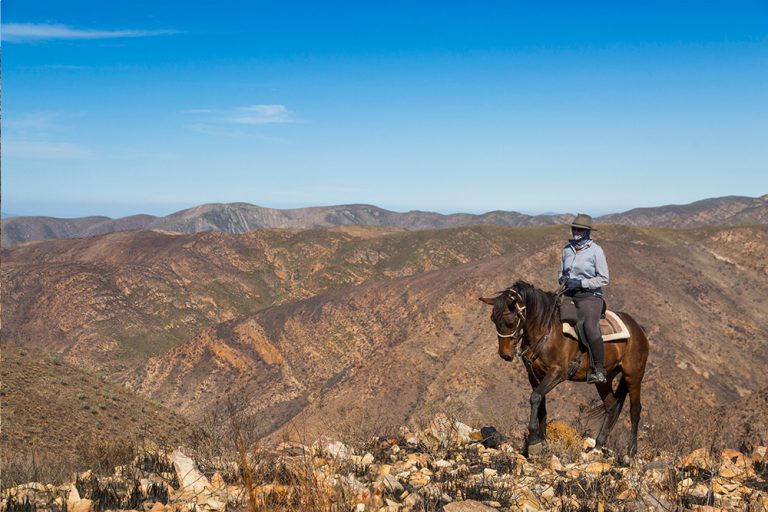
Lynda striking a dramatic pose against the charred mountains.
The second day is a tough one. Hercules, the head horseman, tells us that it involves three hills – and at this point we can only see the first of them. We are heading into the Kouga mountains. The hikers are sore – everyone’s sore – and chatter is at a minimum as we climb slowly up the face of the first hill. Org, one of the hikers, says: ‘By the time we arrive, we’ll know every rock by its name.’ There’s a bracing wind, whistling up the slope even though there’s nothing for it to blow through.
We stop for lunch when the sun is blazing directly overhead, and take the bridles and saddles off the horses, leaving them dozing under a tree. The morning’s roosterkoek has been double-baked in the saddlebag, and it’s tough as I tear it into pieces with my dusty, horsey fingers. It’s hard not to think of us as banditos, slouching through the blackened fynbos, faces obscured by buffs. Avoiding man and law.
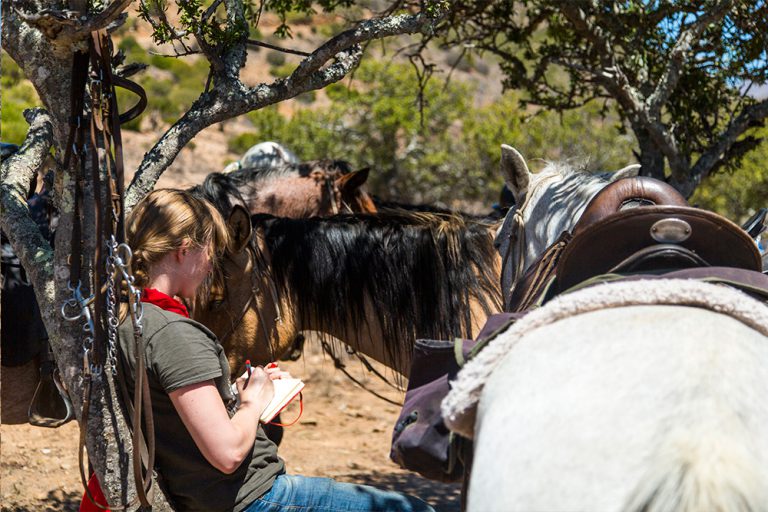
Lunch breaks meant shade, food, and rest – and in my case, note-taking.
It’s while we’re sitting here, trying desperately to avoid the smell of a dead sheep nearby, that Wieda rubs her head against me and I get it – that intoxicating horse magic. A car that is somehow also a pet, a motorbike that has a personality? The witchery of a soft nose, warm skin, the smell of old leather and clinking metal. I get it all.
We saddle up and carry on, carving our way through the mountain until the trail topples over a steep rim and we see the lush folds of the Tsitsikamma rise over to our left. It’s a 360-degree view, as if we’re dancing above the mountains, and they curl like surf as far as the eye can see. After another hill – and another – we turn off the path and ride in between the mountain’s knuckles, dovetailed with a lush green seam running along the bottom. We pitch our tents in paradise valley, happy and plump with accomplishment.
We wake with the birds the next day. A mist has come down, and as we ride into the next valley it’s like descending into a bowl of milk. Pelargoniums burn through the haze, impossibly bright and beaded with dew. After her heroic turn the day before, Wieda’s front leg is bothering her, so I dismount and we walk together. The hikers admit us into their ranks without any gloating, and it’s surprisingly refreshing to change gears into the familiarity of hiking, one foot crunching after the other. I’m still getting a horse’s-eye view of the trail, though. She notices things I wouldn’t – the sweet and delicious flowers of a leucospermum bush, a gnarled tree trunk, the wind in the fynbos.
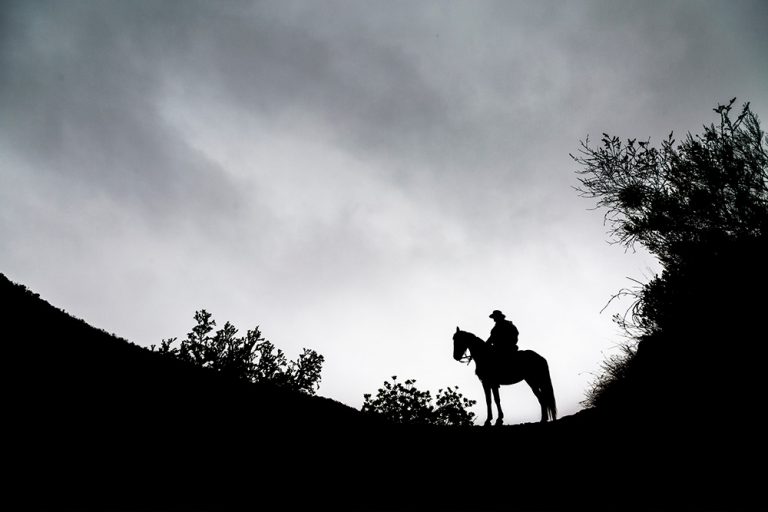
Ominous clouds and patches of mist on day three lent themselves to silhouette shots.
We come down into a valley of towering yellowwoods and eat cold boerie rolls, a light rain misting the horses, making everything opaque. After a long day’s riding the trail crosses a sparkling stream and we see the farmhouse at Ragelsrivier, cupped in the palm of the mountains. We ride through a herd of curious cows, bright as burnished copper. It’s hard not to feel the tug of the alternate universe, where this is what you do every day.
As we huddle around the campfire that night, everyone is hurting. Feet, backs, bums: the pain seems to crack people open a little. There’s something more gentle, more intimate about the stories tonight. Elmien, a teacher from a nearby farm school, makes us dinner. She tells us about her classes, what it’s like to explain hot-air balloons to children who don’t have electricity.
On the last day, it’s time to conquer the Moordenaarskloof – murderer’s valley. As with any place with such an intriguing moniker, there are several robust theories as to how it earned its name, each as unlikely as the last. It’s a long, smooth, steady climb. I’m riding a Scottish Highlander pony today, with a face that matches her adorable name – Custard. Wieda waits behind us. She will be transported to our next spot in a horse trailer, but she doesn’t know that yet, so she whickers anxiously for her friends.
One thing I know from previous trails I’ve done is that there’s usually a moment when the actual riders break away from us ham-fisted pretenders and canter ahead. I’ve always hung back but today, after four days in the saddle, there’s no way I’m staying behind. We come whooping up the hill like outlaws, and I catch a glimpse of Teagan, our photographer: reins in one hand, the other improbably cradling a camera, her eyes ablaze.
And just like that, as if we’ve exceeded the day’s quota of lawlessness and are about to blow our cover, we climb out of the kloof and into rolling farmlands. It’s not far to go.
When we take our last turn down and see the Kouga River snaking deep and dark along the seam of the mountain, it’s the most beautiful thing I’ve ever seen. We’ll be sleeping alongside it tonight. We untack and take the horses to the water; with some chiding, a few are persuaded to swim. Then they roll in the sand on the bank like puppies, delighted to be free of the sweat and effort of the last few days. We have an hour or two to wait until the hikers arrive. Teagan and I doze on the toasty sand, hidden by the rushes, listening to the birds overhead.
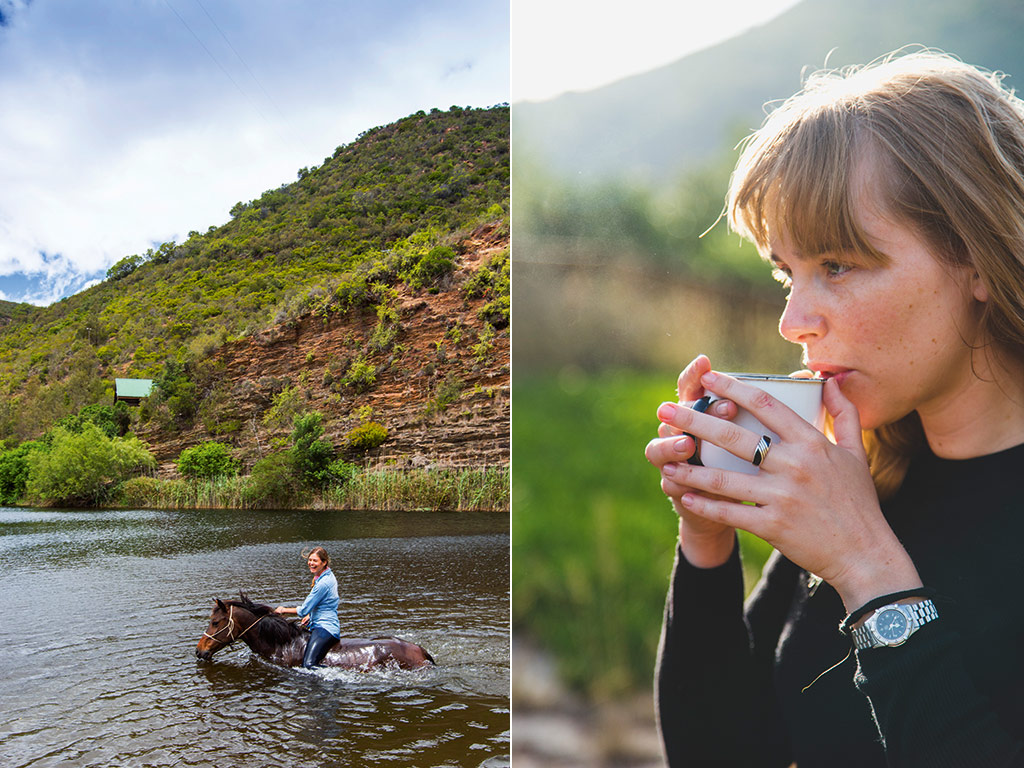
LEFT: You can lead a horse to water. If you’re Teagan, you might even get it to swim. RIGHT: sunrise moerkoffie is essential on the trail.
Someone suggests another ride and our ears prick up. We’ve already arrived at our campsite and there’s nowhere left to go. We saddle up regardless, and as the horses break into a canter and we lean deeper into our saddles, we’re thinking of nothing but the sunset splitting across the plateau, and the wind in our faces.
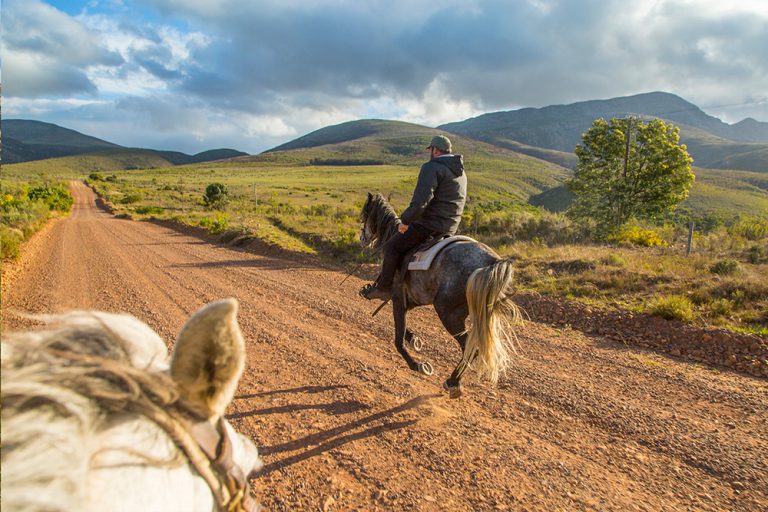
A last canter on the trail. Riding is generally done at a walking pace on the trail, but we couldn’t resist a last surge of speed.
Plan your trip
Getting there
Hikers and riders meet in Steytlerville the night before. Port Elizabeth is the closest airport, about a 90 minutes’ drive (flights from R1 520).
Need to know
If you’re an experienced hiker, it’s certainly worth doing this camino on foot. The horse- riding option opens up this wilderness to beginners, allowing families and groups of differing fitness to do it together. Don’t worry about jodhpurs and boots; thick jeans and good tackies are fine. You’ll be wearing a helmet instead of a sunhat, though, so make sure you’ve got enough sunblock. There’s little signal on the route but there is a satellite phone in case of emergency.
When to go
The Baviaans Camino happens only in the cooler months, from March to September. The next one is on 3 March.
What to bring
You’ll be camping for at least two of the four nights. Bring your own hiking gear, sleeping bag and pillow, as well as alcohol if you’d like it. Tents, mattresses and everything else is provided, including drinking water and all your meals. Fully catered for four nights and five days, it costs R7200 per person for hikers plus an extra R1500 per person for riders. baviaanscamino.com
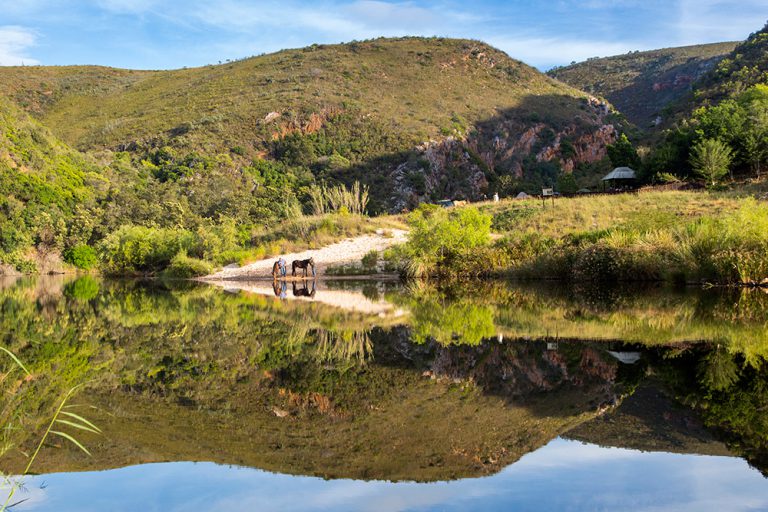
Early morning calm on the last morning of the trail. From here we all went our separate ways – until next time.

This story was first published in the February 2017 issue of Getaway magazine.
Our February issue features a wild new way to traverse the Baviaanskloof, the Okavango Delta’s most affordable safari, 6 local shores to explore and Italy’s 8 prettiest dips.
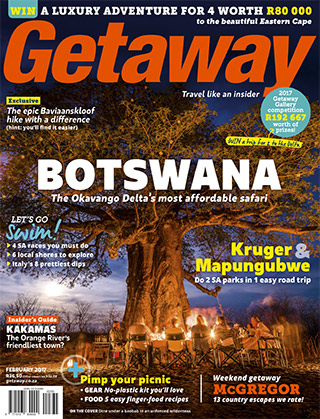
This article, May the horse be with you, was originally posted on the Getaway Blog by Kati Auld.

